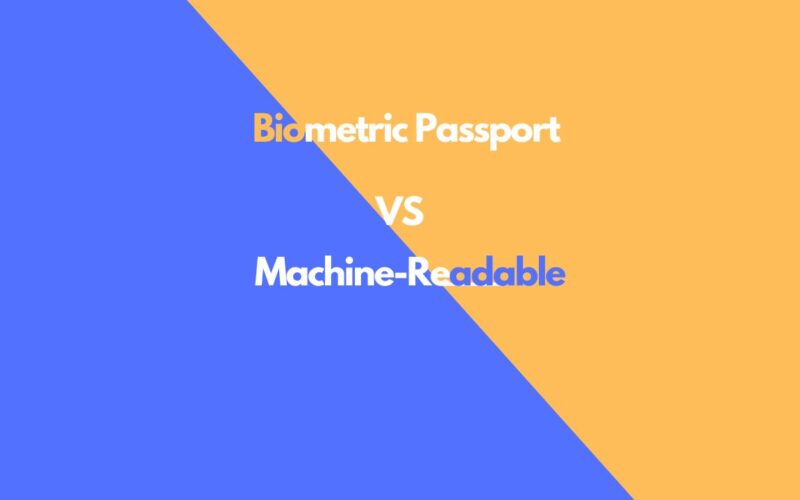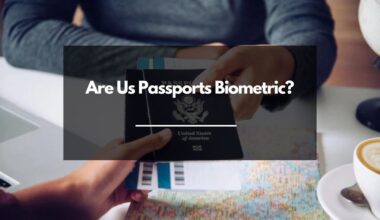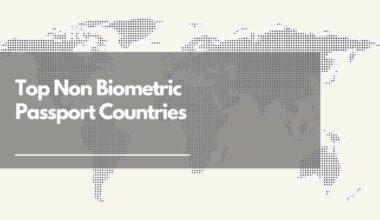As an Amazon Associate, I earn a small commission from qualifying purchases. Learn more about this.
Passports have come a long way from being simple paper documents. Today, we have machine-readable passports and biometric passports, each enhancing the travel experience in its unique way.
In this article, we’d cover the difference between these two passports, discussing what they are, and whether they can be used interchangeably.
What Is A Biometric Passport?
So, what exactly is a biometric passport?
Simply put, a biometric passport is an advanced form of a passport that uses biometric technology to authenticate the identity of travelers.
It’s a part of a broader global initiative to improve data authenticity and enhance border security. But let’s break this down a little more.
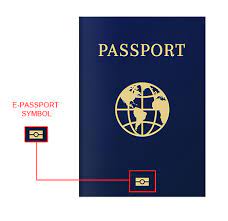
When we talk about ‘biometric’, we’re referring to unique physical or behavioral characteristics that can be used to identify a person.
In the case of biometric passports, also often referred to as e-passports or digital passports, these uniques are typically the passport holder’s face, fingerprints, and sometimes even their iris patterns.
Here’s how it works: your biometric data is stored on a microchip embedded in the passport.
This data is then used to verify your identity. When you’re passing through border control, the data in the chip is compared with the live scan of your face or fingerprints. If the data matches, your identity is verified.
Now, you might wonder, how secure is this?
Well, the chip uses cryptographic techniques to prevent unauthorized access to the data, making it quite secure.
And to take it a step further, the International Civil Aviation Organization (ICAO) sets specific standards for these passports, ensuring their reliability and global interoperability.
What is a Machine Readable Passport?
To put it simply, a machine-readable passport is a passport that contains two lines of printed data at the bottom of the photo page.
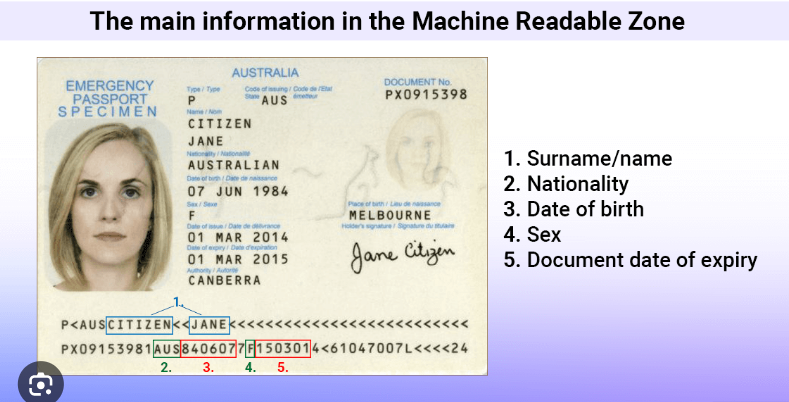
This data, which includes information like your name, passport number, nationality, and date of birth, can be read by machines – hence the term ‘machine-readable’.
Here’s where it gets interesting: the data is not presented in the typical alphabet we use day-to-day.
Instead, it’s presented in a series of characters and numbers according to the standards set by the International Civil Aviation Organization (ICAO).
So, while it may look like a secret code to us humans, for the machines at the airport, it’s a clear, quick, and reliable way to read and verify the information.
When you’re at passport control, this printed data is scanned by an Optical Character Recognition (OCR) reader. The machine decodes the information and verifies it against your travel documents, streamlining the check-in process and reducing human error.
Though a machine-readable passport doesn’t include the same level of high-tech security as a biometric passport, it marked a significant step forward from the handwritten passports of the past.
It improved the speed and accuracy of passport checks, making travel smoother and more efficient.
Read also: How to know If you have an E-passport
Biometric Passport Vs Machine-Readable: The Differences
| Criteria | Biometric Passport | Machine-Readable Passport |
|---|---|---|
| Definition | A passport that includes a microchip embedded in the document. | A passport that has two lines of text as machine-readable zones at the bottom of the data page. |
| Security | High – Biometric features are extremely hard to forge or manipulate. | Medium – More prone to forgery and identity theft than biometric passports. |
| Data Stored | Personal information, facial recognition data, and in some cases, fingerprints and iris scans. | Basic personal information, passport number, nationality, gender, date of birth, and passport expiration date. |
| Usage | Can be used for e-gates at airports, increasing efficiency. | Need to be manually checked by immigration officers. |
| International Acceptance | Widely accepted internationally. | Accepted internationally, but might cause delays in countries where biometric passports are standard. |
| Technology | Incorporates Radio Frequency Identification (RFID) technology. | Incorporates Optical Character Recognition (OCR) technology. |
| Cost | Generally more expensive due to the advanced technology used. | Generally less expensive than biometric passports. |
| Privacy | Enhanced privacy as biometric data is generally only accessible with appropriate scanners. | Lower privacy due to the easily readable nature of the data. |
First up is technology.
Both types of passports incorporate technology, but in very different ways.
Machine-readable passports use optical character recognition technology, which is essentially a fancy way of saying that machines can scan and read the information printed on the passport page.
Biometric passports, on the other hand, take technology up a notch by incorporating a microchip that stores the passport holder’s biometric data, such as facial features and fingerprints.
Security is another key area where these passports differ.
While the machine-readable passport marked a significant improvement from earlier handwritten versions, the level of security it offers pales in comparison to that of a biometric passport.
With its embedded microchip and cryptographic features, the biometric passport is a formidable tool against identity theft and forgery.
Next is the acceptance.
While almost all countries accept machine-readable passports, not all are equipped to fully utilize the features of biometric passports. But they could use the normal features.
Secondly, some countries are moving into generally not accepting any passports besides biometrics, making biometric passports the most versatile.
Can both passports be used interchangeably?
With these two types of passports in circulation, can they be used interchangeably? Well, the short answer is generally yes, but there’s a bit more to it that’s worth discussing.
Whether you’re holding a biometric or a machine-readable passport, both serve the same primary function—to prove your identity and citizenship.
And as such, both types of passports are accepted worldwide for travel. However, the level of ease or convenience might vary depending on the country you’re traveling to and its infrastructure.
If we take a step back, keep in mind that all biometric passports are machine-readable, but not all machine-readable passports are biometric.
This is because biometric passports have an extra feature—a chip that stores biometric data. But they still include the two lines of machine-readable data you’ll find on the page with your photo.
So, in essence, biometric passports come with a bit of a dual function, making them versatile for international travel.
But here’s the thing: while biometric passports are accepted everywhere, not every country is equipped to fully utilize their biometric features.
This is because scanning the biometric data requires specific equipment and software. For countries without this technology, biometric passports are processed as regular machine-readable passports.
This makes them more versatile, as for instance, a country that only accepts Biometric passport won’t be able to use any other passports.
Conclusion
While both biometric and machine-readable passports serve the same basic purpose of verifying the holder’s identity, they do so in very different ways.
Biometric passports offer increased security and advanced technology, but machine-readable passports still play a vital role in global travel, particularly in regions where biometric verification isn’t yet fully implemented
